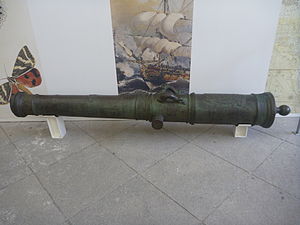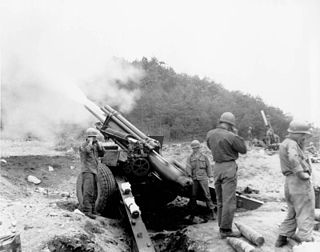
The howitzer is an artillery weapon that falls between a cannon and a mortar. With their long-range capabilities, howitzers can be used to great effect in a battery formation with other artillery pieces, such as long-barreled guns, mortars, and rocket artillery.

A carronade is a short smoothbore cast-iron cannon which was used by the Royal Navy. It was first produced by the Carron Company, an ironworks in Falkirk, Scotland, and was used from the mid-18th century to the mid-19th century. Its main function was to serve as a powerful, short-range, anti-ship and anti-crew weapon. The technology behind the carronade was greater dimensional precision, with the shot fitting more closely in the barrel thus transmitting more of the propellant charge's energy to the projectile, allowing a lighter gun using less gunpowder to be effective.

The French 75 mm field gun is a quick-firing field artillery piece adopted in March 1898. Its official French designation was: Matériel de 75 mm Mle 1897. It was commonly known as the French 75, simply the 75 and Soixante-Quinze. The French 75 was designed as an anti-personnel weapon system for delivering large volumes of time-fused shrapnel shells on enemy troops advancing in the open. After 1915 and the onset of trench warfare, impact-detonated high-explosive shells prevailed. By 1918 the 75s became the main agents of delivery for toxic gas shells. The 75s also became widely used as truck mounted anti-aircraft artillery. They were the main armament of the Saint-Chamond tank in 1918.
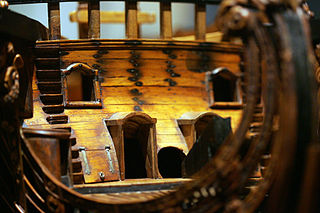
A chase gun, usually distinguished as bow chaser and stern chaser, was a cannon mounted in the bow or stern of a sailing ship. They were used to attempt to slow down an enemy ship either chasing (pursuing) or being chased, when the ship's broadside could not be brought to bear. Typically, the chasers were used to attempt to damage the rigging and thereby cause the target to lose performance.
Naval artillery in the Age of Sail encompasses the period of roughly 1571–1862: when large, sail-powered wooden naval warships dominated the high seas, mounting a large variety of types and sizes of cannon as their main armament. By modern standards, these cannon were extremely inefficient, difficult to load, and short ranged. These characteristics, along with the handling and seamanship of the ships that mounted them, defined the environment in which the naval tactics in the Age of Sail developed.

The Gribeauval system was an artillery system introduced by Lieutenant General Jean Baptiste Vaquette de Gribeauval during the 18th century. This system revolutionized French cannons, with a new production system that allowed lighter, more uniform guns without sacrificing range. The Gribeauval system superseded the Vallière system beginning in 1765. The new guns contributed to French military victories during the French Revolutionary Wars and Napoleonic Wars. The system included improvements to cannons, howitzers, and mortars. The Year XI system partly replaced the field guns in 1803 and the Valée system completely superseded the Gribeauval system in 1829.

The Canon de 12 Gribeauval or 12-pounder was a French cannon and part of the system developed by Jean Baptiste Vaquette de Gribeauval. There were 1.079 English pounds in the Old French pound, making the weight of shot nearly 13 English pounds. The 12-pounder was the heaviest cannon in the French field artillery; the others were the light Canon de 4 Gribeauval and the medium Canon de 8 Gribeauval. Superseding the previous Vallière system, the Gribeauval system was adopted in 1765 and its guns were first used during the American Revolutionary War. The greatest use of Gribeauval guns came during the French Revolutionary Wars and the Napoleonic Wars. During the latter wars, the 12-pounder was often employed in corps artillery reserves. Because of their physical and psychological effect, Emperor Napoleon increased the number of 12-pounders in his artillery and fondly called the cannons his belles filles. Gribeauval cannons fired canister shot for close-range work and round shot at more distant targets. In 1803 the Year XI system was introduced, but it only partly replaced the Gribeauval system which was not completely replaced until the Valée system was set up in 1829.

The Canon de 8 Gribeauval or 8-pounder was a French cannon and part of the Gribeauval system developed by Jean Baptiste Vaquette de Gribeauval. The Old French pound was 1.07916 English pounds, making the weight of shot about 8.633 English pounds. The 8-pounder was the medium weight cannon of the French field artillery; the others were the light Canon de 4 Gribeauval and the heavy Canon de 12 Gribeauval. Replacing the older Vallière system, the Gribeauval system was introduced in 1765 and the guns were first employed during the American Revolutionary War. The most extensive use of Gribeauval guns was during the French Revolutionary Wars and the Napoleonic Wars. The 8-pounder could be found in divisional reserves, advanced guards or army artillery reserves. Emperor Napoleon began to phase out the 8-pounder by increasing the proportion of 12-pounders in his artillery. The emperor began switching calibers to the handier 6-pounder piece, utilizing captured guns as well as newly designed French cannons. The Year XI system began in 1803, but it only partly replaced the Gribeauval system which was not entirely suppressed until the Valée system was introduced in 1829.

The traditional French units of measurement prior to metrication were established under Charlemagne during the Carolingian Renaissance. Based on contemporary Byzantine and ancient Roman measures, the system established some consistency across his empire but, after his death, the empire fragmented and subsequent rulers and various localities introduced their own variants. Some of Charlemagne's units, such as the king's foot remained virtually unchanged for about a thousand years, while others important to commerce—such as the French ell used for cloth and the French pound used for amounts—varied dramatically from locality to locality. By the 18th century, the number of units of measure had grown to the extent that it was almost impossible to keep track of them and one of the major legacies of the French Revolution was the dramatic rationalization of measures as the new metric system. The change was extremely unpopular, however, and a metricized version of the traditional units—the mesures usuelles—had to be brought back into use for several decades.

The 36-pounder long gun was the largest piece of artillery mounted on French warships of the Age of Sail. They were also used for Coastal defense and fortification. They largely exceeded the heaviest guns fielded by the Army, which were 24-pounder long guns. The nominal weight of shot was 36 French livres, 17.6 kg (38.8 lb).
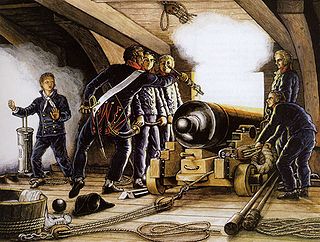
The 18-pounder long gun was an intermediary calibre piece of naval artillery mounted on warships of the Age of Sail. They were used as main guns on the most typical frigates of the early 19th century, on the second deck of third-rate ships of the line, and even on the third deck of late first-rate ships of the line.

The obusier de vaisseau was a light piece of naval artillery with a large calibre mounted on French warships of the Age of Sail. Designed to fire explosive shells at a low velocity, they were an answer to the carronade in the close combat and anti-personnel role. However, their intended ammunition proved too dangerous for the crew, and the French navy phased them out at the beginning of the Empire in favour of the carronade.
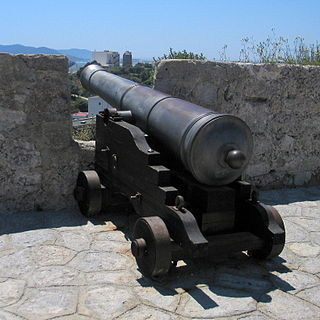
The 24-pounder long gun was a heavy calibre piece of artillery mounted on warships of the Age of Sail. 24-pounders were in service in the navies of France, Spain, Great Britain, the Netherlands, Sweden, and the United States. They were comparable to the Canon de 24 Gribeauval used by the French Army as its largest piece of siege artillery. 24-pounders were used as main guns on the heaviest frigates of the early 19th century and on fourth-rate ships of the line, on the second deck of first-rate ships of the line, and on the second deck of a few large third-rates.

The 12-pounder long gun was an intermediary calibre piece of artillery mounted on warships of the Age of Sail. They were used as main guns on the most typical frigates of the early 18th century, on the second deck of fourth-rate ships of the line, and on the upper decks or castles of 80-gun and 120-gun ships of the line. Naval 12-pounders were similar to 12-pound Army guns in the Gribeauval system: the canon lourd de 12 Gribeauval, used as a siege weapon, and the canon de 12 Gribeauval, which was considered a heavy field artillery piece.

A gunport is an opening in the side of the hull of a ship, above the waterline, which allows the muzzle of artillery pieces mounted on the gun deck to fire outside. The origin of this technology is not precisely known, but can be traced back to the late 15th century, with the appearance of artillery in naval warfare. Ships featuring gunports were said to be pierced, since the ports were cut through the hull after the construction.
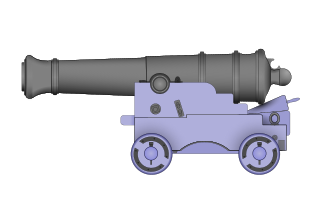
The 30-pounder long gun was a large piece of artillery mounted on French warships of the Age of Sail. They were the heaviest component of the unified system standardised on the 30-pounder calibre, replacing both the 36-pounder long guns in their usages, and even some 24-pounders.

The 18-pounder short gun was an intermediary calibre piece of artillery mounted on warships and merchantmen of the Age of sail. It was a lighter version of the 18-pounder long gun, compromising power and range for weight.

The Canon de 4 Gribeauval or 4-pounder was a French cannon and part of the artillery system developed by Jean Baptiste Vaquette de Gribeauval. The Old French pound was 1.079 English pounds, making the weight of shot about 4.3 English pounds. In the Gribeauval era, the 4-pounder was the lightest weight cannon of the French field artillery; the others were the medium Canon de 8 Gribeauval and the heavy Canon de 12 Gribeauval. The Gribeauval system was introduced in 1765 and the guns were first employed during the American Revolutionary War. The most large-scale use of Gribeauval guns occurred during the French Revolutionary Wars and the Napoleonic Wars. At first a pair of 4-pounders were assigned to each infantry battalion and were often called battalion pieces. Later, Emperor Napoleon took the guns away from the infantry units and began to replace the 4-pounder with the 6-pounder, using captured guns as well as newly cast French cannons. However, as the French infantry declined in quality after 1809, the 4-pounders were reintroduced in order to provide direct support for formations of foot soldiers. All Gribeauval cannons were capable of firing canister shot at close-range and round shot at long-range targets. The Gribeauval system supplanted the older Vallière system, was partly replaced by the Year XI system in 1803 and completely superseded by the Valée system in 1829.

Hébé was a 38-gun warship of the French Navy, and lead ship of the Hébé-class frigate. The British Royal Navy captured her in 1782 and took her into service as HMS Hebe, before renaming her HMS Blonde in 1805.
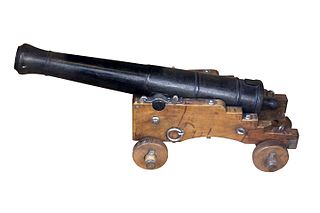
The 8-pounder short gun was a light calibre piece of artillery mounted on French warships of the Age of sail. They were used as main guns on light ships of the early 19th century, and on the quarterdeck and forecastle of ships of the line. They were similar in design to the Canon de 8 Gribeauval.
